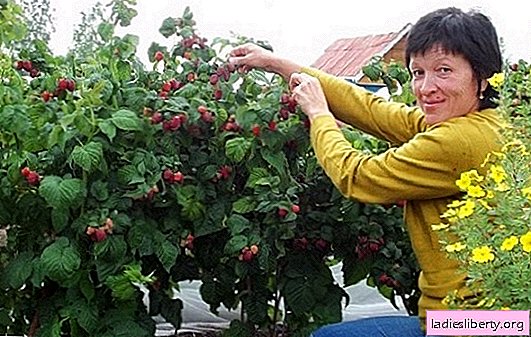
If you select the “right” raspberry variety, the bush will take root even in the northern regions of the country. The plant is often propagated by cuttings or layering. But planting it with seeds among amateur gardeners is not too common - the method is quite complicated.
Growing raspberries on fertile soils and ensuring proper care, you can collect from 1 bush to 4 kg of delicious berries.
Fruits the plant more often in the second year after planting. In the south of the country, you can harvest the first crop already in the current season.
What kind of raspberries to plant?
Raspberries belongs to the family Pink. This is a bush with straight spiked stems. Fruits, depending on the particular variety, have a color from yellow to almost black.
Breeders bred many varieties of raspberries. All of them are divided into 3 groups:
• Traditional raspberries. Varieties - Credo, Reward, Malakhovka, Sunny, Relight, Balm, Hussar, Brilliant, Runaway, Meteor, Mishutka. The shrub is distinguished by good endurance and regular productivity. The plant develops a lot of root growth. Berries - Medium
• Repair raspberries. Varieties - Apricot, Atlas, Eurasia, Crane, Golden Autumn, mulatto, Indian summer, Diamond, Golden giant, Hercules, Bryansk divo. These are high-yielding varieties resistant to frost and giving abundant harvests. It is common practice when the bush of repair raspberries is cut to the root immediately after fruiting - the yield for the next season will be significantly higher. Many varieties are resistant to diseases and pests.
• Large-fruited. Varieties - Abundant, Scarlet Sails, Mirage, Patricia, Arbat, Maroseyka, Vega, Bryansk, Cascade, Lazorevskaya, Lashka. Varieties are distinguished by the large size of the fruits. But many of them do not tolerate cold snap - even in the middle lane for the winter will have to cover the bushes. The berries are juicy, delicious, and well tolerate transportation.
When choosing a raspberry variety for planting on your site, consider the climatic conditions in the region, the timing of fruit ripening and the plant's resistance to diseases and pests.
Where to plant raspberries?
Raspberries loves good lighting, so pick out new gardeners unshaded area. Bushes can be planted both individually (in holes), and in rows (in trenches).
Despite the fact that raspberries need regular watering, it will not tolerate waterlogging in the beds. Plant plants where groundwater flows deeper than 1.5 m from the surface of the earth. The optimum acidity of the soil is 5.5-6. If necessary, carry out additional agricultural activities so that the acidity does not exceed these values.
For spring planting of seedlings, prepare the site since the fall. And if you are going to do planting work in the fall, carefully dig the beds in at least 3 months. Digging depth - 30 cm. Process the earth with herbicides, add minerals and organic matter.
Follow crop rotation rules. Bad neighbors and predecessors for raspberries will be tomatoes, potatoes, strawberries.
Preparing planting material
Choose healthy seedlings with a developed root system for planting. Inspect the planting material - it should not have traces of diseases and insect pests. It is better to buy it in specialized nurseries - here you will be provided with all quality certificates for planting material.

Raspberry seedlings
In the future, you yourself can propagate raspberries to increase the planting area. To do this, you can use the following parts of the bush:
• green or lignified root offspring,
• rooted shoot tip,
• root cuttings with kidneys.
Seedlings are prepared for planting in the fall (from mid-September to October) or in the spring (late April). It is considered the best autumn landing. That's just not possible in all regions - young shoots can not withstand frosts. Before the planting from the seedling, you need to cut off all the extra shoots. Roots for better survival can be treated with special solutions.
Whatever time you choose for planting, follow the deadlines - you need to root the seedling until the buds bloom on it!
Planting raspberries in the holes
To plant a seedling in pits, make indentations 40 * 40 * 50 cm deep in the ground. Follow the following planting pattern - 2 * 0.5 m. Lower the plant into a hole and sprinkle with a layer of fertile soil. At the same time, do not deepen it deeply, since a root bud can rot. Make sure that the root neck is a couple of centimeters above ground level.

Raspberry planting pattern
After planting a seedling, water the ground. If there are fears that the roots will freeze, mulch the trunk section.
Raspberry Trench Landing
The trench planting of raspberry bushes is more suitable for those gardeners who have set themselves the goal of annually collecting large yields of delicious berries. This option can significantly save the free area of the garden - plants will be located in one line.
For planting, prepare a trench ≈45-50 cm deep. The landing line should be located from north to south. Keep a distance of 40 cm between the bushes and 1 m between the rows. Fill the trench with a nutrient mixture - manure, topsoil, superphosphate. The substrate should take 15-20 cm.
Nitrogen supplements do not use yet - raspberries will be badly rooted!
Seedlings are buried in trenches on the same principle as in a pit. Planting then water and mulch.
Raspberry Care
Even an amateur gardener can cope with raspberry care. If you follow the rules, the bush will bring a bountiful harvest. What is important?
• Watering. Shrub responds well to watering. But there is no need to overdo it - if an abundance of moisture accumulates on the beds, one cannot avoid fungal infections. Raspberries planted in the spring need more regular watering. If there was a dry summer, regularly check the condition of the earth in tree-trunk circles - from lack of water, the roots quickly dry out.
• Loosening. Raspberries do not like weeds, so spud up the soil more often, especially after watering. Do not dig the beds deep so as not to damage the root system.
• Mulching. Regularly update mulch on the beds if your site cannot boast of well-drained, light soil. You can use straw, wood chips and shavings, freshly cut grass. The use of a newspaper as a mulch is excellent in practice - just spread the paper in several layers under the bushes.

Mulching Raspberries
• Fertilizer. Raspberries especially need timely nutrition in the first years of growth. In spring, fertilize the bushes with organics - a solution of bird droppings (1 kg per 10 l) has proven itself in practice. The resulting mass is then diluted with water in a ratio of 1:10. Many gardeners spray young shoots of plants with EM drugs. They also serve as excellent prophylaxis against diseases. In autumn, raspberries can be fed with ash infusion - 2 cups of ash per 10 liters of water. For fertilizer, 2-3 liters of liquid top-dressing is poured under each bush.
• Pruning. Regularly break dried inflorescences and leaves from twigs. Do not allow a thick bush to thicken, as this can lead to a decrease in yield and the development of fungal diseases. To do this, starting from the 2nd year of planting, after harvesting, shorten the stems under the root. After hibernation, remove the shoots from the plant to a strong bud. Watch the growth of young shoots during the season - ideally, raspberries should have no more than 5 shoots.

Raspberry pruning
The gardener should think in advance how to garter raspberry bushes.
An overgrown plant will bend to the ground, which can lead to breakage of branches, decay of berries and the appearance of diseases.
Proper raspberry garter will contribute to abundant harvests and make it easier to care for.
If the bushes are planted one by one, then it is better to use a fan-like way to garter them. To do this, drive 2 sticks between the plants, to which you tie a part of the shoots from one and the other instance. It turns out a kind of fan.

Raspberry Fan Garter
Are you going to raise raspberries trench method? Then it is better to put into practice a trellis garter. At the same time, along each trench, stakes are driven into the ground, between which 2 rows of wire, a strong thread or twine are stretched. The lower thread is located at a height of ≈70 cm from the soil, the upper thread is 120-140 cm.
Tighten the wire so that it does not then bend under the weight of the branches and from gusts of wind. Raspberry shoots while they are small evenly attach to the bobbin thread. In the future, as the plant develops, tie the stems to the upper tier of the trellis system.

Raspberry trellis system
Raspberry Shelter for the Winter
Winter-hardy raspberries in the southern climate will calmly survive the winter without shelter. But in regions where the temperature often drops below -20 ˚C, bushes should be prepared for the cold.
With autumn pruning, the plants are shortened. Bend the shoots to the ground, tie them up, if necessary, fix them to the ground.
As a covering material, it is better to use non-woven material.
In winter, inspect the raspberry - suddenly, the edges of the fabric will bend under the gusts of strong winds.

Kicking raspberries for the winter
How to protect raspberries from diseases and pests?
The sweet raspberry aroma attracts pests. And if you violate the conditions of the plant, not to avoid disease. Their appearance is facilitated by overflow of soil and thickened foliage.
Among the insects dangerous for raspberries, we distinguish:
• Raspberry stem fly. You can easily find out that the bug settled on the bushes - the tops of young stems wither and bend a little. The caterpillars of the insect bring great harm to raspberries - they eat branches. It is bad that the stem fly can winter in the ground, returning to the plant next season. In order not to miss the invasion, regularly inspect the raspberry. If larvae are found on the plant, cut off the tops of the shoots below the place where they found the pest. Chemical processing of raspberries is allowed only as a last resort. Spraying before flowering 1-2 times.

Damage from Raspberry Stem Flies
• Raspberry beetle. Beetles themselves and their larvae damage the plant - they feed on flowers, berries and raspberry leaves. To prevent the spread of the pest, regularly loosen the soil around the bushes and remove weeds from the site. Cut and burn damaged parts of the plant. Chemicals against raspberry beetle during flowering can not be sprayed with bushes.

Raspberry beetle on raspberry inflorescences
• Raspberry stem gall midge. Insects attack raspberries during the flowering period of the bushes. On the shoots, where the bugs were laying larvae, swellings appear - it is from them that the stem gall midge can be recognized. Be sure to remove damaged stems from the plant and burn. If healthy shoots are enough, raspberries will continue to delight you with a plentiful harvest.
• Raspberry kidney moth. The pest eats the kidneys, damages the shoots - as a result, the bush brings fewer berries at the end of the season, branches and leaves wither. If you find a kidney fly, it is better to cut off raspberry shoots to the very base and destroy. In the fall, the bush can be treated with special chemicals - for example, fufanon.
• Raspberry tick. The insect settles on the inside of the leaves. All green is eventually covered with pale greenish spots. It is difficult to fight with a tick - it is much simpler to observe safety measures - to remove the faded shoots. Immediately purchase raspberry varieties that are resistant to this pest.

Raspberry Tick Damage
When using chemicals to spray raspberries, take precautions as you are dealing with fruit bushes. The manufacturer must indicate on the packaging for the tool instructions and exact dosages.
Among the diseases affecting raspberry, we can distinguish:
• Purple spotting. Purple stains appear on the stems and leaves. The whole plant is gradually affected, it dies. If the injuries are still slight, spraying with special preparations will help.

Purple spotting on raspberry leaves
• Verticillin wilt. The causative agent of the fungal disease is in the ground and can persist here for a very long time. Raspberry turns yellow, leaves fall, the main stem dies over time. Upon detection of the first "symptoms", it is better to completely uproot the plant from the beds.
• Root rot. The root neck of raspberries turns brown and completely collapses - rarely a copy can be saved. Remove the diseased plant from the site so that other plants here are not infected.
Many gardeners easily manage to grow healthy raspberry bushes, which bring abundant harvests every season.











